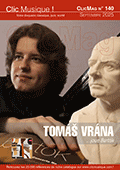 Parfois le héros d’un disque n’est pas celui que l’on croit. Audite publie un album consacré à Pierre Fournier proposant uniquement des prises de concert non publiés jusqu’alors. Le disque s’ouvre par une énième version du Concerto de Dvorak…..qui ne nous en apprendra pas plus sur Fournier, sinon qu’il entre ce soir du 16 aout 1967 dans son opus favori avec un archet un rien raide – cela s’arrange à mesure et le chant le reprendra généreusement peu après. Oui mais voila, c’est Istvan Kertesz qui dirige une formation de circonstance, le Swiss Festival Orchestra, et lui donne dés son ouverture une carrure et un élan sciants. Tout du long ce sera d’abord son concerto, tempétueux, emporté, ouvrant sur de larges paysages, porté par une maitrise du discours qui m’a laissé incrédule. En plus, il ne l’avait jamais enregistré. Voila un apport majeur à sa discographie ! Tout aussi surprenant, cinq années lus tôt, Pierre Fournier, l’Orchestre Philharmonique de la RTF et Jean Martinon délivrent une interprétation brillantissime du Premier Concerto de Camille Saint-Saëns qu’ils avaient fixé au studio pour la Deutsche Grammophon en 1960. Ah, l’élan et le chic de Fournier sont irrésistibles ici, avec le sel particulier du concert qui enflamme également Martinon, direction claire qui sait ce que dialoguer signifie. En complément, Fournier joue à la mémoire d’Enrico Mainardi El cant dels ocells de Pablo Casals. L’annonce nous restitue sa voix, cette diction si typique d’une certaine époque, qui incluait la ponctuation dans le rythme de la phrase, ce qu’au fond scander veut dire (Discophilia - Artalinna.com). (Jean-Charles Hoffelé)  Tout comme le Don Quichotte de Richard Strauss, le violoncelliste français Pierre Fournier (1906-1986) s’est vraiment approprié le Concerto pour violoncelle en si mineur d’Antonín Dvorák, l’ayant gravé trois fois dont deux avec Rafael Kubelík (octobre 1948 et juin 1954) et le troisième avec George Szell (juin 1962). Et le miracle est ici d’autant plus précieux qu’il le joue avec István Kertész (1929-1973), immense interprète de Dvorák mais qui n’a pas eu le temps de le confier au disque en raison de son décès prématuré dû à une noyade. Quant au Concerto pour violoncelle n°1 en la mineur de Saint-Saëns, sa gravure la plus célèbre chez Deutsche Grammophon est précisément dirigée par le chef de cet enregistrement public, le grand chef français Jean Martinon (1910-1976). Ensuite, en un français impeccable qui semble à jamais révolu, il nous présente les circonstances de son exécution du Chant des oiseaux de Pablo Casals. Dans ces trois œuvres magnifiques, Pierre Fournier nous offre un jeu d’une richesse et d’une pureté somptueuses alliées à une expression d’une simplicité émouvante. Un pur bonheur musical de tous les instants ! (Michel Tibbaut)  Pierre Fournier (1906-1986) was one of the most eminent cellists of the generation after Pablo Casals. Praised as an “aristocrat of cello playing”, he was admired for his soulful, singing tone, his uncomplicated elegance and his refined sound. This disc presents three live recordings from this legacy, recorded at LUCERNE FESTIVAL and all of them released for the first time. Together with István Kertész, Fournier performed a piece of his core repertoire in the summer of 1967: Antonín Dvorák’s Cello Concerto in B minor, Op. 104 – a particularly noteworthy archive discovery since the conductor’s tragically early death had prevented him from making a studio recording of the concerto. This live recording preserves the unpredictable emotional value of the concert situation: Fournier and Kertész take many risks, preferring the high definition of separate sounds as well as fresh tempi, without any temptation to fall for folklore frenzy or sentimental melancholy. Camille Saint-Saëns’ First Cello Concerto in A minor, Op. 33 was held in low esteem for decades, despite composers such as Rachmaninov and Shostakovich declaring it “the greatest of all cello concertos”. It was not revived until the Fifties and Sixties – not least thanks to its advocacy by Pierre Fournier. In 1962, alongside Jean Martinon and the Orchestre Philharmonique de la RTF, he presented a passionate reading of the work, permitting a telling comparison to his previous studio recording. A new item in Fournier’s discography, however, is the Cant dels ocells which he played in 1976 at a memorial concert on the centenary of Pablo Casals’ birthday – this was also his last appearance at LUCERNE FESTIVAL. Fournier’s brief announcement before this work has been included here: in it he pays tribute both to Pablo Casals – whose cello version of the old Catalan Christmas carol became an obligatory constituent of his concerts and a secret hymn for all refugees and emigrants longing for home – and also to the cellist and composer Enrico Mainardi, who had died only a few months previously, on 10 April 1976. In cooperation with audite, LUCERNE FESTIVAL presents outstanding concert recordings of artists who have shaped the festival throughout its history. The aim of this CD edition is to rediscover treasures – most of which have not been released previously – from the first six decades of the festival. These recordings have been made available by the archives of SRF Swiss Radio and Television, which has broadcast the Lucerne concerts from the outset. Carefully re-mastered and supplemented with photos and materials from the LUCERNE FESTIVAL archive, they represent a sonic history of the festival.
 |
